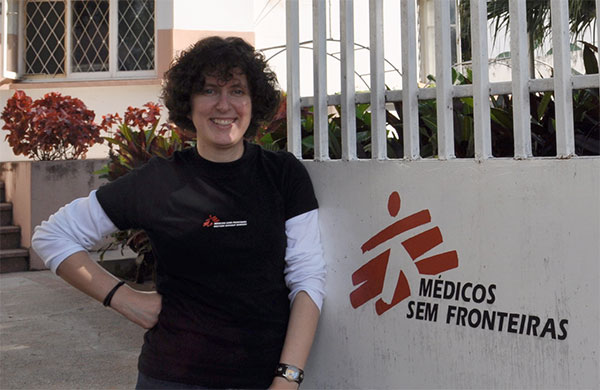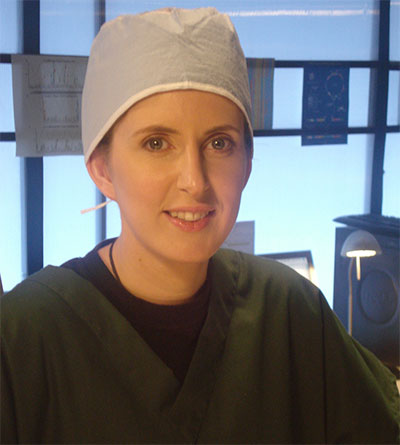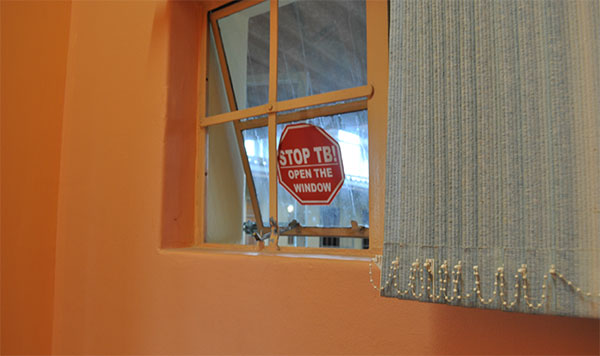
As Covid-19 began spreading across the world, bats, who are known carriers of coronaviruses, began getting a bad reputation. But could these flying mammals and their ability to evade infection from these very viruses hold the key to treating Covid-19? That’s what Angelique Corthals, Ph.D., Associate Professor in the Department of Sciences, is hoping to learn through her work in two rapid-response projects funded by the National Science Foundation’s Division of Integrative Organismal Systems (NSF, IOS). “We’re not sure yet if bats are the true reservoir of SARS-CoV-2, the virus that causes Covid-19 in humans, but we do know they are the reservoirs of SARS and MERS,” she says, “And, we know that bats are almost immune from the illnesses caused by these viruses.”
Corthals, who is also a forensic anthropologist and biomedical researcher, isn’t new to the world of diseases and viruses. Her biomedical research has focused on autoimmune diseases like multiple sclerosis, and during her time working with Doctors Without Borders she helped reimagine clinical protocols and testing practices of Tuberculosis (TB) patients and HIV patients in some of Africa’s most resource-limited communities. With the novel coronavirus, she’s just as eager to take on the challenge of resolving some of the ambiguities surrounding the virus and finding a possible pathway to a vaccine. “What I’m interested in is not only the origin of the disease and the process of how its evolved, but also how we can stop the spread and prevent the next pandemic,” Corthals explains.

“The hope is that through the research, we’ll figure out what proteins in the immune system can be targeted and used for immunization.” —Angelique Corthals
Analyzing the Data
Examining how bats with SARS-CoV-2 can be infected but not affected by the virus is at the core of the research project titled: Collaborative Research: Immunological adaptations in bats to moderate the effect of coronavirus infection. Corthals, and Stony Brook University’s Liliana Davalos, Ph.D, a professor in the Department of Ecology and Evolution, will work with Texas Tech University’s Department of Biological Sciences Associate Professor David Ray, Ph.D., who’s leading the project, to compare the genomes of bats that harbor viruses but escape infection, against bats that don’t harbor viruses at all. “We want to take a look at the differences in the immune systems between these bats, and then figure out what kind of evolutionary history can we infer from the data, and what are the differences and similarities between the genomes,” says Corthals. “The hope is that through the research, we’ll figure out what proteins in the immune system can be targeted and used for immunization.” Finding these “better targets” is fundamental to creating a vaccine that effectively blocks the virus. “These proteins can be targets for a vaccine and they’ll ‘switch off’ the invasion of the virus into your immune cells. The vaccine will essentially boost up these protein targets, enabling them to recognize the virus when it comes into the body and stop the virus from spreading.”
Studying an Evolving Virus
By now, artistic renderings of the SARS-CoV-2 virus have become a familiar staple on the evening news—that ever-present sphere with spikes poking out, and it’s those spikes that play a pivotal role in the virus’s ability to be so infectious. “The spikes cling on to a cell’s receptors and begin the virus’s invasion on your immune system,” says Corthals, explaining how the virus works. “What we’re seeing with the newest mutation, detected by the Scripps Institute, is that while the virus isn’t more lethal, it’s definitely more infectious and spreading more easily. And, that’s happening because the virus has multiplied the number of spikes that it has so it can attach better to your cells and infect you.”

“Goblet cells are found in nasal passages, the eyes, the lungs, the throat—essentially anywhere mucin is produced—and these are the areas that are very susceptible to SARS-CoV-2.” —Angelica Corthals
Examining Goblet Cells
Mucins, which are large glycoproteins, are the major macromolecular components of mucus. Mucin-producing goblet cells are taking center stage in Corthals’ second NSF-funded collaborative project: Bat goblet cells work as immuno-hotspots for infections of coronavirus. Corthals will once again team up with Davalos, the project’s lead, and Laurel Yohe, Ph.D., a postdoctoral researcher in the Department of Geology & Geophysics at Yale University, to examine how viruses attack goblet cells in bats upon entry into their nasal passages. The team’s theory is that the virus must be attacking goblet cells in bats and humans differently. “If we go through all the Covid-19 symptoms and we look at the sites in the human body that Covid-19 affects, the one commonality is the goblet cells. In humans, goblet cells are found in nasal passages, the eyes, the lungs, the throat—essentially anywhere mucin is produced—and these are the areas that are very susceptible to SARS-CoV-2,” says Corthals, adding that goblet cells don’t just produce mucin, they have immune and inflammatory functions as well. “Why is it that both humans and bats can have SARS-CoV-2, yet humans are infected by the virus, but bats are resistant to it? Could it be that upon entry of the virus goblet cells in bats contain the virus and then dissolve it? Or is it that bats have fewer goblet cells in their upper respiratory tract, making them less susceptible to being invaded by the virus? These are some of the questions we’re hoping to answer with this research.”
“Our hope is that the discoveries will also enable the surveillance of bat populations, so that we’ll know when a new virus is brewing and stop the transmission to humans.” —Angelique Corthals
Stopping the Next Pandemic
With just one year to conduct both research projects, Corthals admits she’s feeling the pressure but she’s incredibly confident in the abilities of both teams to deliver results. “We already have a ton of data to analyze and we’re going to gather a lot of new information about bats and their immunity to viruses that will inform us about treatments and immunizations,” she says. “Our hope is that the discoveries will also enable the surveillance of bat populations, so that we’ll know when a new virus is brewing and stop the transmission to humans. Our ultimate goal is to prevent the next pandemic.”

“We know SARS-CoV-2 travels in the air, so if you can’t open a window and ventilate an area, you’re going to be in bad shape.” —Angelique Corthals
Letting In Fresh Air
While the world waits for a vaccine, cases in the U.S. are again on the rise. So, how can we help slow the spread of the virus? Beyond wearing a mask in public, getting tested, and practicing social distancing, Corthals suggests a simple, yet effective action: Opening a window when you’re indoors. “When I worked with Doctors Without Borders in South Africa, my office in the HIV/TB Clinic had a sign that said, ‘Stop TB, Open the Window.’ Ventilation is really important,” she explains. “We know SARS-CoV-2 travels in the air, so if you can’t open a window and ventilate an area, you’re going to be in bad shape. The air droplets will stay in the space. And, if you have an HVAC [heating, ventilation, and air conditioning] system instead of a window, you’re just going to recirculate the same air, you’re recirculating those droplets, and you’re infecting a massive amount of people. So please, wear a mask, keep your social distance, get tested, and if you’re indoors, open a window.”



